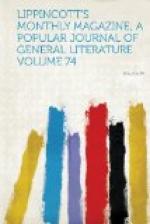A stronger chain of evidence (still conjectural, it must be remembered) points to Ben Jonson as this rival poet. His Epigrams, which contain a eulogy upon Pembroke, and his Catiline, were both dedicated to this earl, although neither of them was published till after the Sonnets. We find the earl of Pembroke’s name among the actors in Ben Jonson’s masques, and Falkland’s eclogue testifies to their intimacy. And in the 80th Sonnet, Shakespeare uses the same comparison of himself and his rival, to two ships of different bulk, which Fuller used to describe Shakespeare and Ben Jonson as they appeared at the Mermaid Tavern.
As for the name of the false woman who ensnared two such noble hearts, it is lost for ever, let us hope, in a deserved oblivion. The scanty data that we have given here are about all that can be accepted without wrenching history and poetry from their proper sphere. But so long as the spirit is more than the letter, so long will the Sonnets of Shakespeare be read by all true lovers of true poetry, whether their historical significance ever be known or not. They are the saddest and the sweetest story of friendship that we have in all literature; and while one faithful friend remains possessed of that fine wit that can “hear with eyes what silent love hath writ,” his heart will beat in answer to the perfect love of the greatest of all poets and the noblest of all friends.
KATE HILLARD.
OUR MONTHLY GOSSIP.
ARTISTS’ MODELS IN ROME.
Some visitors to the Eternal City leave it without having found time to see this one of its wonders, while others are driven by the sad inelasticity of the hours to leave a different class of objects for “another time.” But it may be safely asserted that none who have been at Rome for even twenty-four hours ever left it without having had their attention forcibly arrested by the groups of painters’ and sculptors’ models—the former mainly—who haunt the upper part of the great steps that lead up from the Piazza di Spagna to the Trinita di Monti, and perhaps even more specially the corner where the Via Sistina falls into the Piazza Barberini. But very few probably have asked for, and fewer still obtained, information as to who and what these people are, and whence they come. Yet to an attentive observer many points about the appearance of these groups must suggest that a curious interest might attach itself to the reply to such questions. There are sights in Rome of grander and greater interest, but there is nothing in all the famous centre of the Catholic world more distinctively, essentially and exclusively Roman, more unlike anything that is seen elsewhere, more instinct with couleur locale, than these singularly picturesque groups of nomads.




